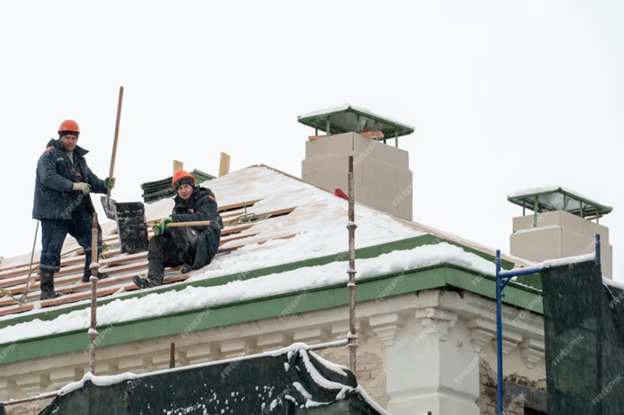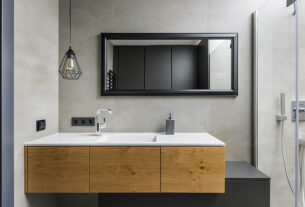The moment you step inside your newly built home, a sense of accomplishment washes over you. It’s a culmination of dreams, plans, and meticulous construction. But before you celebrate fully, remember the silent guardian that stands between you and the elements – the roof. A properly designed and installed roof is the first line of defense for your haven, safeguarding your family and belongings for years to come.
This comprehensive guide dives into the world of residential roof installation, equipping you with the knowledge to make informed decisions for your new construction project. We’ll also explore how the residential roof install process lays the foundation for a trouble-free future, minimizing the need for premature roof replacement.
Planning and Design: Shaping Your Sanctuary’s Shield
The roof installation process begins long before the first shingle is laid. Here’s where the groundwork for a long-lasting and robust roof is established:
- Architectural Collaboration: Your architect and roofing contractor work together to design a roof that complements your home’s architectural style. This involves selecting a roof pitch, shape (gable, hip, etc.), and material that not only enhances your home’s aesthetics but also functions effectively in your specific climate. For example, a steeper roof pitch might be ideal for areas with heavy snowfall, while a flatter roof might be more suitable for hot, dry climates.
- Material Matters: Choosing the right roofing material is crucial for both aesthetics and longevity. Popular options include asphalt shingles, metal roofing, tile, and slate. Each material offers different benefits and drawbacks in terms of durability, cost, maintenance requirements, and visual appeal. Your architect and roofing contractor can guide you through the pros and cons of each option to ensure you select a material that suits your needs and complements the overall design of your home.
Building a Strong Foundation: The Importance of Structural Integrity
A strong and secure roof deck forms the foundation for your roof’s longevity. Here’s how it’s constructed:
- Deck Construction: The roof deck serves as the platform upon which the roofing materials will be installed. It’s typically constructed from plywood or oriented strand board (OSB) securely attached to the trusses or rafters of your home’s roof structure. The specific thickness and type of wood used might vary depending on the chosen roofing material and local building codes.
- Underlayment – The Hidden Hero: A layer of underlayment is installed directly on top of the roof deck. This waterproof barrier acts as a critical second line of defense against moisture infiltration. Different types of underlayment are available, each offering varying levels of water resistance and breathability. Choosing the right underlayment is crucial for preventing leaks and promoting optimal roof ventilation.
Putting Up the Shield: Installing the Roofing Material
With the foundation laid, it’s time for the installation of the chosen roofing material:
- Shingle or Panel Application: For asphalt shingles, meticulous installation is key. Roofing contractors ensure proper shingle alignment and overlapping to create a watertight barrier. Metal roofing panels are typically fastened to the roof deck using specialized clips and screws, ensuring a secure and weatherproof installation.
- Flashing for Added Protection: Flashing plays a vital role in preventing leaks around chimneys, vents, skylights, and other roof penetrations. Roofing contractors meticulously install and seal flashing material around these areas, creating a watertight barrier that prevents moisture from entering your home.
- Ventilation – Ensuring a Healthy Roof: Proper roof ventilation is crucial for preventing moisture buildup, which can lead to mold growth, rot, and premature roof deterioration. Ventilation systems can include ridge vents, soffit vents, or a combination of both, depending on the roof design. Proper ventilation not only extends the lifespan of your roof but also improves energy efficiency by allowing heat to escape during the summer months.
- Inspection and Finishing Touches: Once the installation is complete, a thorough inspection is conducted to ensure everything is installed correctly and according to building code requirements. This includes checking for proper flashing installation, shingle alignment, and overall workmanship. Finally, the roofing crew will clean up any debris from the installation process, leaving you with a pristine and weatherproof roof for your new home.
Building for the Future: How Installation Impacts Roof Replacement
A meticulously planned and executed roof installation paves the way for a trouble-free future. Here’s how:
- Focus on Quality Materials: Using high-quality roofing materials, properly installed, minimizes the risk of premature roof failure due to material defects or improper installation. This can significantly delay the need for a costly roof replacement down the line.
- Proper Ventilation: Adequate ventilation prevents moisture buildup, a primary culprit in roof deterioration. A well-ventilated roof can last significantly longer, reducing the chances of needing





